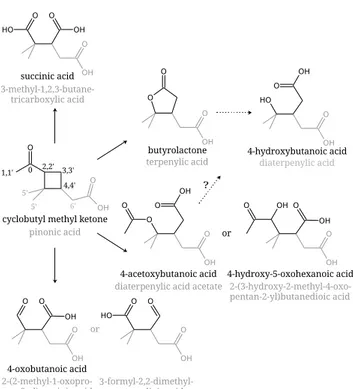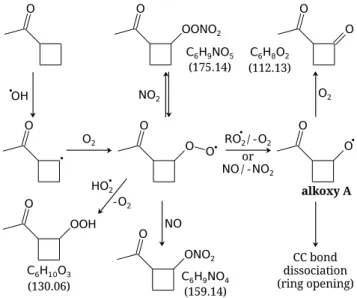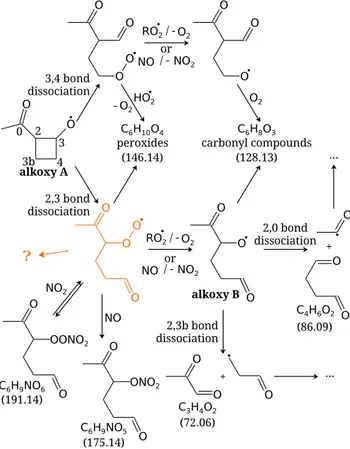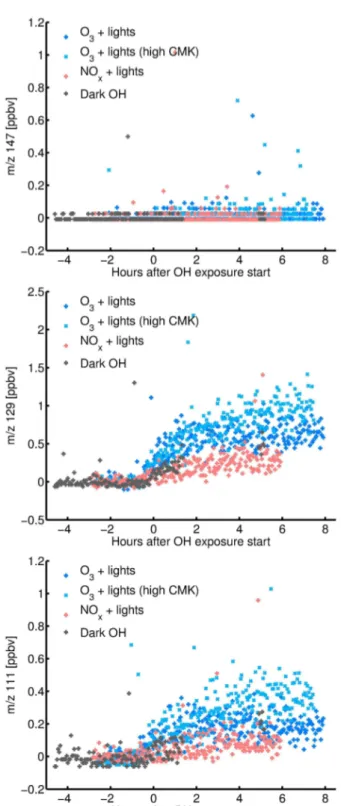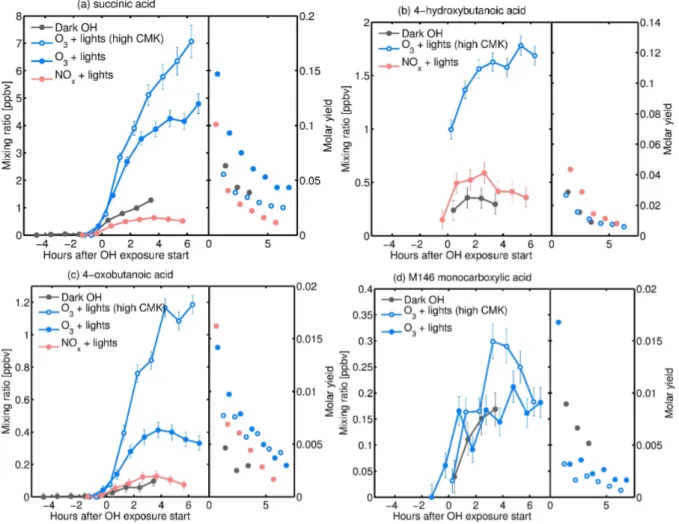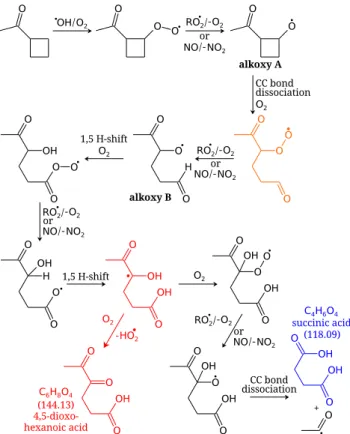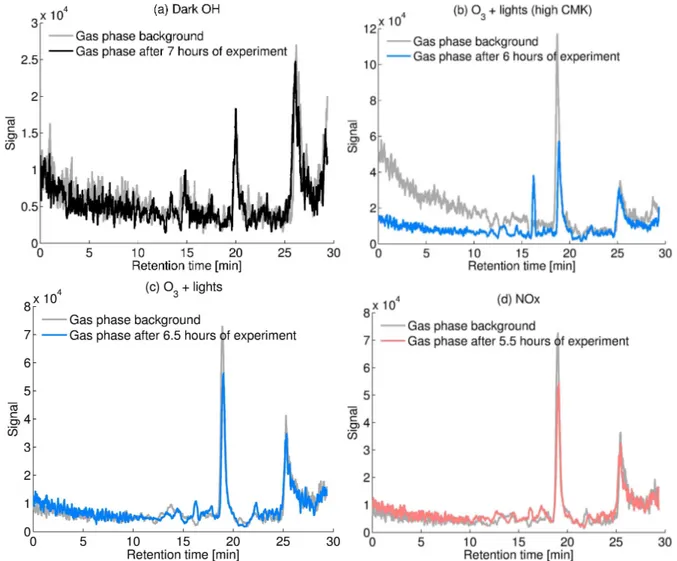www.atmos-chem-phys.net/12/10749/2012/ doi:10.5194/acp-12-10749-2012
© Author(s) 2012. CC Attribution 3.0 License.
Chemistry
and Physics
Cyclobutyl methyl ketone as a model compound for pinonic acid to
elucidate oxidation mechanisms
A. P. Praplan1,*, P. Barmet1, J. Dommen1, and U. Baltensperger1
1Laboratory of Atmospheric Chemistry, Paul Scherrer Institute, Villigen PSI, Switzerland *now at: Department of Physics, University of Helsinki, Helsinki, Finland
Correspondence to:J. Dommen (josef.dommen@psi.ch)
Received: 27 March 2012 – Published in Atmos. Chem. Phys. Discuss.: 24 April 2012 Revised: 29 October 2012 – Accepted: 29 October 2012 – Published: 16 November 2012
Abstract. Although oxidation of the atmospherically rel-evant compound α-pinene has been extensively studied, chemical mechanisms leading to the formation of later gen-eration oxidation products remain poorly understood. The present work uses cyclobutyl methyl ketone (CMK) to study the oxidation mechanism of pinonic acid, anα-pinene reac-tion product, by hydroxyl radicals (OH). CMK has a simi-lar but simpler chemical structure compared to pinonic acid. Succinic acid, 4-hydroxybutanoic acid and 4-oxobutanoic acid were identified as first generation products of CMK. These observed organic acids were compared to compounds found in secondary organic aerosol formed from the ox-idation of α-pinene. Results suggest that 3-methyl-1,2,3-butanetricarboxylic acid (MBTCA), terpenylic acid and di-aterpenylic acid acetate are first generation products of OH oxidation of pinonic acid. Therefore, there is strong evidence thatOH oxidation greatly increases the oxygenation of or-ganic compounds (e.g. monocarboxylic acid to tricarboxylic acid) through radical mechanisms, without requiring a stable intermediate. These observations cannot be explained by tra-ditional atmospheric chemistry mechanisms.
1 Introduction
Monoterpenes are biogenic volatile organic compounds (VOCs) emitted into the atmosphere by vegetation. They represent 11 % of the total biogenic VOC emissions (Guen-ther et al., 1995).α-Pinene is a major representative of this class of compounds and can form secondary organic aerosol (SOA). However, the understanding of its oxidation mecha-nisms and SOA formation yield is still subject of research.
Szmigielski et al. (2007) identified 3-methyl-1,2,3-butanetricarboxylic acid (MBTCA) as a product from α -pinene SOA. Because of its high oxygen-to-carbon (O:C) ratio and its distinct structure, it was suggested as a tracer compound for aged α-pinene SOA. M¨uller et al. (2012) demonstrated experimentally that MBTCA is generated from pinonic acid oxidation by hydroxyl radicals (OH), where pinonic acid is a primary product from α-pinene ozonoly-sis. The structures of further products ofα-pinene SOA were identified recently: terpenylic acid and diaterpenylic acid ac-etate (Iinuma et al., 2008; Claeys et al., 2009).
Fig. 1.Chemical structures of cyclobutyl methyl ketone (CMK) and measured or expected products. The added grey moieties represent the analogous products in the pinonic acid system. Butyrolactone (and terpenylic acid) are expected to hydrolyse during sampling, so that 4-hydroxybutanoic acid (or diaterpenylic acid) are detected. No equivalent product of 4-oxobutanoic acid was identified yet, so that two possible structures are proposed for the pinonic acid system: 2-(2-methyl-1-oxopropan-2-yl)succinic acid and 3-formyl-2,2-dimethylpentanedioic acid. The numbers on CMK/pinonic acid correspond to carbon atoms bound to hydrogen atom(s) available for abstraction by an hydroxyl radical (OH).
same way as terpenylic acid) is expected to be hydrolysed during sampling with water (Sect. 2), so that it is detected as 4-hydroxybutanoic acid. It is however not possible to deter-mine which amount of this acid is formed directly in the gas phase and which amount results from the hydrolysis of the lactone. Because diaterpenylic acid (hydrolysed form) is usu-ally detected in small amounts in ambient samples compared to terpenylic acid (lactone), one may assume that it is formed from the hydrolysis of the lactone. Because 4-oxobutanoic acid was observed during CMK oxidation experiments, it is included in Fig. 1 and two possible structures for analogous products from theα-pinene (or pinonic acid) oxidation are suggested.
2 Experimental
2.1 Smog chamber and experiments
The experiments presented in Table 1 were performed at the smog chamber of the Paul Scherrer Institute (Paulsen et al.,
2005). It consists of a 27-m3Teflon®bag irradiated by Xe-arc lamps (4×4 kW) and additional black light tubes emit-ting mainly between 320 and 400 nm (manufactured by Cleo Performance; 80×100 W).
Two different ways of producing OH were used: (1) production by tetramethylethene (TME) ozonolysis (”Dark OH”), and (2) production by ozone (O
3) photolysis in the
absence (”Lights + O3”) or in the presence of nitrogen
ox-ides (NOx, ”Lights + NOx). In the NOxexperiment, the lights
were turned off after 3 h ofOH exposure in order to observe the decomposition of peroxyacyl nitrates (PANs). CMK was injected through a heated sample bulb (80◦C). The experi-ments performed with 400 ppbv CMK were also seeded with wet ammonium sulphate aerosol particles, while the experi-ment with 1600 ppbv CMK (“high CMK”) was not. The rel-ative humidity was around 50 % in all experiments.
2.2 Instruments
In addition to the usual monitors (for O3and NOx) and
sen-sors (temperature and relative humidity), a proton-transfer-reaction mass spectrometer (PTR-MS) was used to anal-yse gas phase organic compounds. PTR-MS data were cor-rected for background. Organic acids were sampled in the gas phase by a wet effluent diffusion denuder (WEDD) and in the aerosol phase by an aerosol collector (AC) described in Takeuchi et al. (2004) and (2005), respectively. The sam-pling time was 30 min and anions were concentrated on two trace anion concentrator columns (TAC-LP1, Dionex). Sam-pling and analysis of gas and aerosol phase were performed alternatingly on each TAC (one for each phase). The separa-tion of the analytes was performed by ion chromatography (Dionex DX600 with guard column NG1 and analytical col-umn AS11-HC) with a gradient eluent (0–60 mM OH−).
De-tection was performed after background suppression (Anion Self-Regenerating Suppressor, ASRS 300 2 mm, Dionex) by conductivity detection and by a quadrupole mass spectrom-eter (ThermoScientific MSQ) with electrospray ionisation in negative mode (Fisseha et al., 2004).
3 Results and discussion
For all the experiments performed, no significant aerosol for-mation was observed, so that the discussion focuses on the gas phase observations. Furthermore, no mass increase in the particle phase was measured when seed aerosol was used.
Because MBTCA could be observed inα-pinene oxidation experiments in the absence of NOx(M¨uller et al., 2012), our
interpretation of the oxidation mechanism is mainly based on the low-NOxregime. The experiment with NOxwas
Table 1.List of performed cyclobutyl methyl ketone (CMK) oxidation experiments.
Date CMK1 O31 NOx1 1CMK2 Seed concentration3 Comments
29 Jul 2010 400 ppbv 500 ppbv – 30 ppbv 40 µgm−3 TME ozonolysis (“DarkOH”)
18 Oct 2010 1600 ppbv 400 ppbv – 145 ppbv no seed lights on for 7.5 h (“Lights + O3, high CMK”) 20 Oct 2010 400 ppbv 400 ppbv – 56 ppbv 38 µgm−3 lights on for 7.25 h (“Lights + O3”)
22 Oct 2010 400 ppbv – 400 ppbv NO 27 ppbv 17 µgm−3 lights on for 3 h 400 ppbv NO2 (“Lights + NOx”)
1Nominal concentrations2after 3 h of oxidation3at the beginning of the oxidation.
Table 2.Reaction rate constants for hydrogen atom abstraction from cyclobutyl methyl ketone (CMK) by a hydroxyl radical (OH).
In-dices correspond to the carbon atom numbers in Fig. 1.
cyclobutyl methyl ketone (CMK)
k1 0.102×10−12cm3s−1 k2 0.616×10−12cm3s−1 k3(twice) 1.255×10−12cm3s−1 k4 0.396×10−12cm3s−1
pinonic acid
k′1 0.102×10−12cm3s−1 k′2 0.616×10−12cm3s−1 k′3 1.255×10−12cm3s−1 k′4 1.011×10−12cm3s−1 k′5(twice) 0.167×10−12cm3s−1 k′6 0.862×10−12cm3s−1
3.1 Hydrogen abstraction
CMK reacts only withOH, which abstracts a hydrogen atom (H), forming an alkyl radical. Table 2 presents the reaction rates for the different possible hydrogen atom abstraction re-actions from CMK byOH, derived from structure-activity relationship estimations (Kwok and Atkinson, 1995; Atkin-son, 1997). The indices correspond to the atom numbers in Fig. 1. The fastest abstraction occurs at position 3 for CMK and two such positions are available due to the symmetry of the molecule. Therefore, this route is considered to dominate the gas phase oxidation of CMK. Note that there is only one equivalent position in pinonic acid (3′) and that positions 4′ and 6′ (due to the presence of the carboxylic group) show
competitive reaction rates. Therefore, the analogous products from hydrogen abstraction at position 3′in the pinonic acid
system are expected to have lower yields. In addition, other products are formed in the pinonic acid system which cannot be studied with CMK.
The mechanism following the hydrogen atom abstraction at position 3 is depicted in Fig. 2. The alkyl radical (R) formed reacts immediately with molecular oxygen (O2) to
form a peroxy radical (RO
2). This radical can then react
with a hydroperoxyl radical (HO
2) to form a hydroperoxide
Fig. 2.Chemical mechanism following hydrogen atom abstraction from cyclobutyl methyl ketone (CMK) by a hydroxyl radical (OH).
The numbers in brackets correspond to the molar mass of the com-pounds. See text for details.
(C6H10O3) or, in the absence of NOx, it can react with
an-other RO
2to form an alkoxy radical (RO, labelled “alkoxy
A” in Fig. 2) as well as alcohol and carbonyl compounds (not shown). In the high NOx case, hydroperoxide
forma-tion is suppressed by either the formaforma-tion of a peroxynitrate (ROONO2) or RO
2reaction with NO to form ROand NO2
or a nitrate.
Figure 3 showsm/z131 and 113, respectively, as mea-sured with the PTR-MS. The hydroperoxide C6H10O3
should appear atm/z131, however, as it looses one water molecule after protonation in the PTR-MS, it is not detected atm/z131 ([M+H]+), but at m/z113 ([M+H−H2O]+).
At thism/z, 2-acetylcyclobutanone (C6H8O2) also appears
as an interference. In the NOx experiment, only the latter
compound contributes to the signal because the hydroper-oxide formation is hindered by the presence of NO, lower-ing the HO
2concentration. However, Fig. 3b shows that the
Fig. 3.Signals ofm/z131 (top) and 113 (bottom) from the proton-transfer-reaction mass spectrometer (PTR-MS). The hydroperoxide C6H10O3 is mainly detected at m/z113 since it looses a water molecule during protonation in the ionisation region of the PTR-MS. However, at this m/z there is an interference with the 2-acetylcyclobutanone (C6H8O2), which is still measured in the ex-periment with NOx, while the hydroperoxide formation channel is suppressed.
with O2, due to the release of the ring strain (∼27 kcal mol−1,
Peeters et al., 2004).
3.2 Carbon-carbon bonds dissociation
The two possible ring opening reactions from the “alkoxy A” and the following mechanistic steps are depicted in Fig. 4. These reactions are expected to occur faster than the bimolec-ular reaction with O2 as previously mentioned. According
to structure-activity relationships (Peeters et al., 2004), but without considering the ring strain release discussed above, the 2–3 carbon-carbon bond dissociation is expected to be favoured because carbon 2 is more substituted than carbon 4. The energy barrier is 3.1 kcal mol−1lower in the former case.
Fig. 4. Ring opening chemical mechanism of the alkoxy radical A from Fig. 2. Carbon-carbon bond 2–3 or 3–4 can dissociate, lead-ing to the formation of different compounds. The formed “alkoxy B” can also undergo carbon-carbon bond dissociation. The num-bers in brackets correspond to the molar mass of the compounds. See text for more details.
Peeters et al. (2004) discussed the effect of resonance stabil-isation and, because the alkyl radical formed by dissociation of the 2–3 carbon-carbon bond is resonance-stabilised by the carbonyl group, its formation is even more favoured and this route is expected to dominate over the other.
Following the ring opening reaction, the formed alkyl rad-ical reacts rapidly with O2to form a peroxy radical. This
rad-ical can react with HO
2to form a hydroperoxide with a
nom-inal mass of 146 or it can also react with either RO
2or NO (in
the NOxexperiment) to form another alkoxy radical (“alkoxy
B”). Upon reaction with O2, this alkoxy radical forms
4,5-dioxohexanal (nominal mass 128). Figure 5 shows the PTR-MS signals form/z147, 129 and 111.m/z147 would corre-spond to the hydroperoxide, but no signal is seen.m/z129 corresponds to either 4,5-dioxohexanal or the hydroperox-ide fragment ([M+H−H2O]+) with a signal below 1.5 ppbv.
Fig. 5.Signals of the proton-transfer-reaction mass spectrometer (PTR-MS) form/z147 (top), 129 (middle) and 111 (bottom). The hydroperoxides C6O4H10are not detected atm/z147 due to a wa-ter molecule loss during protonation but rather atm/z129, where the carbonyl compounds C6O3H8are detected. Because these car-bonyl compounds are aldehydes, they also possibly loose a water molecule during protonation and some signal appears atm/z111.
Fig. 6. Signals of the proton-transfer-reaction mass spectrometer (PTR-MS) form/z87 (top) and 73 (bottom).m/z87 is the signal for succinic aldehyde andm/z73 for methylglyoxal.
The previously described alkoxy radical (B) can also un-dergo carbon-carbon bond dissociation. Due to the presence of the carbonyl group at position 5 (see Fig. 4), the en-ergy barrier for the dissociation of the 2–0 bond is reduced by 8 kcal mol−1according to structure-activity relationships (Peeters et al., 2004) compared to the 2–3b bond dissocia-tion. For this reason, the elimination of the acetyl radical is favoured. This is confirmed by the PTR-MS with the signals for m/z87 (corresponding to succinic aldehyde, C4H6O2)
and m/z73 (corresponding to methylglyoxal, C3H4O2) as
Fig. 7. Mixing ratios (left axis) and molar yields (right axis) of acids observed: (a)succinic acid, (b) 4-hydroxybutanoic acid, (c) 4-oxobutanoic acid, and(d)monocarboxylic acid with molar mass 146.
O3experiments. Because methylglyoxal is also formed in the
darkOH experiment from the ozonolysis of TME, the inter-pretation of these results is more difficult, but no change in them/z73 increase rate can be observed while the increase ofm/z87 is small due to the small amount of CMK reacted. The most intriguing observation is the rapid signal increase for m/z87 in the NOx experiment while the lights are on.
This may be due to the fragmentation of organonitrates of higher mass. However, no structure and formation mecha-nism can be proposed for this observation. It would also not make sense that the presence of NOx simply favours one
carbon-carbon bond dissociation of the alkoxy radical over the other. However, the presence of NOxsuppresses the
re-action of “alkoxy B” with another RO
2to form alcohol and
carbonyl compounds (not shown), so that more “alkoxy B” is produced and, subsequently, more succinic aldehyde. 3.3 Organic acids formation mechanism
The reactions discussed so far do not lead to the formation of organic acids. However, organic acids are indeed formed as
shown in Fig. 7. The mixing ratios of all organic acids pre-sented in Fig. 1 increase immediately after the start of the oxidation, indicating that these organic acids are first gener-ation products (first non-radical species). This suggests that terpenylic acid and diaterpenylic acid acetate could be prod-ucts of the pinonic acid oxidation byOH. This also implies that it is possible to add two carboxylic acid functionalities to a compound within one generation (from CMK to succinic acid or from pinonic acid to MBTCA). This reaction may proceed via a sequence of several radical intermediates. Suc-cinic acid, 4-oxobutanoic acid and 4-hydroxybutanoic acid were quantified based on calibration with standards. The monocarboxylic acid with nominal mass 146 could corre-spond to 4-acetoxybutanoic acid, but this could not be con-firmed due to the lack of an available standard. Therefore, this species was quantified based on the calibration of 4-hydroxybutanoic acid. This unknown acid could also con-tribute to the PTR-MSm/z129 signal (Fig. 5).
Fig. 8.Chemical mechanism of the reaction between the peroxy-acyl radical with the hydroperoxyl radical (HO
2) forming either a peracid or an organic acid and ozone (O3). In the presence of nitro-gen oxides (NOx), the HO
2concentration will be reduced by nitro-gen monoxide (NO) and a peroxyacyl nitrate (PAN) can be formed from the reaction of the peroxyacyl radical with nitrogen dioxide (NO2). The numbers in brackets correspond to the molar mass of the compounds.
precursor reacted. Succinic acid has a molar yield of a few percent, while the other organic acids presented in Fig. 7 have molar yields of less than 1 %.
The formation mechanisms of these organic acids remain unclear, but their low molar yields indicate that they may arise from minor processes. Hydrogen atom migration from the aldehyde moiety of the radical “alkoxy B” presented in Fig. 4 would lead to the formation of a peroxyacyl radical (R(O)OO), which by reaction with HO
2 can form either
a peracid (RC(O)OOH) or a carboxylic acid (and O3) as
de-picted in Fig. 8. Note that 4-hydroxy-5-oxohexanoic acid has a nominal mass 146 and could be the one measured and at-tributed to 4-acetoxybutanoic acid, as no standard was avail-able to confirm the retention time of either of these species. This product with nominal mass 146 is not formed in the presence of NOx, which would be compatible with the
for-mation of peroxyacylnitrate C6H9NO7 as the
hydroperox-ide formation channel is suppressed in the presence of NO2.
Moreover, it may be that 4-acetoxybutanoic acid is hydrol-ysed during sampling (similarly to lactone) and is detected as hydroxybutanoic acid. The analogous compound of 4-hydroxy-5-oxohexanoic in the pinonic acid system would be an isomer of diaterpenylic acid acetate with the same chemi-cal structure (C10H16O6) and nominal mass 232 (depicted in
Fig. 1).
M¨uller et al. (2012) suggested several mechanisms for the formation of MBTCA from pinonic acid. One of them includes an intermediate stable compound (i.e. non-radical compound), so that it cannot be used to interpret the present
Fig. 9.Suggested formation mechanism of succinic acid adapted from the 3-methyl-1,2,3-butanetricarboxylic acid (MBTCA) forma-tion mechanism of M¨uller et al. (2012) (black path). The interme-diate alkyl radical marked in red is expected to react with O2 pref-erentially by hydrogen atom abstraction to form 4,5-dioxohexanoic acid. For simplification, alkyl radicals are not depicted as they re-act immediately with O2to form peroxy radicals. The numbers in brackets correspond to the molar mass of the compounds.
results. Because succinic acid is formed as a first genera-tion compound in the experiments presented here, a mech-anism without any stable (non-radical) intermediate is re-quired. M¨uller et al. (2012) also suggested pathways without stable intermediate products. However these mechanisms re-quire an intramolecular hydrogen atom shift to an acyloxy radical (see Fig. 9). This kind of unimolecular reaction was already suggested by Jenkin et al. (2000) for the formation of pinic acid. However, based on structure-activity relation-ships, Vereecken and Peeters (2010) reported acyloxy migra-tion rates at 298 K and 1 atm in the order of 9.3×103 to 1.1×105s−1, while the derived carbon dioxide (CO2) loss
Fig. 10.Chromatograms ofm/z143 for the four different experiments:(a)dark hydroxyl radical (OH) production(b)ozone (O3) photolysis
with 1600 ppbv cyclobutyl methyl ketone (CMK),(c)O3photolysis, and(d)O3photolysis in the presence of nitrogen oxides (NOx). The grey chromatogram in each plot corresponds to the gas phase background measured before the lights were turned on.
Furthermore, the alkyl radical marked in red in Fig. 9 is expected to react preferentially with O2by hydrogen atom
abstraction and formation of a carbonyl functional group, leading to 4,5-dioxohexanoic acid (C6O4H8) with a
nom-inal mass of 144. It was not possible to identify any first-generation monocarboxylic acid with IC/MS atm/z143 (see the chromatogram of Fig. 10). The peak at retention time (RT)∼19 min is present in the background and does not in-crease during photooxidation of CMK. Only in the experi-ment with high CMK (Fig. 10b) another peak appears around 16 min. However, because this RT is higher than 15 min, it is expected to be a dicarboxylic acid and from its time trend (data not shown), it seems to be a second generation product. Similar to this minor dicarboxylic acid peak at
m/z143, other peaks were identified (e.g. at m/z129 withRT ∼13 min) which were not included in the present discussion. Nevertheless, they illustrate the mechanistic
complexity of the CMK oxidation and the need to better understand organic acid formation in the gas phase. Also small organic acids such as formic acid, acetic acid, lactic acid and pyruvic acid were observed. Because these can arise from several reaction pathways, they were not used to interpret the mechanism of the present discussion.
3.4 Non-traditional chemistry
As already mentioned, a key compound seems to be the peroxy radical marked in orange in Fig. 4 because after elim-ination of the acyl moiety, it remains with four carbon atoms that are common to the organic acids presented in Fig. 7. Un-known reaction pathways are therefore symbolised by an or-ange question mark. Quantum chemistry calculations esti-mate that the rate constant for that 1,6-H shift at 298 K in this peroxy radical (Figs. 4 and 9) is about 100 s−1 (Neuen-schwander, 2012), which is orders of magnitude faster than the intermolecular reactions considered. Further exploration of this possible mechanism would be highly speculative and beyond the scope of the present work.
4 Conclusions
Using CMK as a model compound, it is possible to study the gas phase reactions following the opening of the four-carbon ring present in the chemical structures of many terpenoids. M¨uller et al. (2012) already demonstrated that MBTCA can be formed from theOH oxidation of pinonic acid. In the CMK system, the analogue of MBTCA, suc-cinic acid, was measured with molar yields of 2 to 5 %. 4-Hydroxybutanoic acid could also be identified as analogue of diaterpenylic acid, resulting from the hydrolysis of buty-rolactone (analogue of terpenylic acid). A monocarboxylic acid with nominal mass 146 which could be the analogue of diaterpenylic acid acetate was measured in the absence of NOx. However, due to the lack of an available
stan-dard, this analogy could not be confirmed. Moreover, it re-mains unclear if 4-acetoxybutanoic acid would hydrolyse similarly to butyrolactone during sampling with water and be detected as 4-hydroxybutanoic acid. Its formation suppres-sion by NOx could not be interpreted mechanistically. The
signal atm/z146 could also be attributed to 4-hydroxy-5-oxohexanoic acid.
4-Oxobutanoic acid was identified and two analogue structures are proposed that would correspond to 2-(2-methyl-1-oxopropan-2-yl)succinic acid and 3-formyl-2,2-dimethylpentanedioic acid. Claeys et al. (2009) identified inα-pinene SOA a compound with the same nominal mass (188), but tentatively attributed a slightly different structure to it. By understanding the reaction mechanisms, structures can be proposed in the context of a precursor oxidation, so that out of the many possible compounds derived from a chemical formula, the ones that are relevant for the sys-tem observed can be selected. For this, the simplified CMK system is a useful tool, because it focuses on the reactive sub-structure of the terpenes.
All the compounds measured in this work are first-generation oxidation products. This demonstrates that two carboxylic acid functionalities can be added in one oxida-tion step, increasing rapidly the O:C ratio and the poten-tial of SOA formation from VOC oxidation. Very often, off-line filter analyses do not provide information on the
tem-poral evolution of a compound, so that mechanisms involv-ing many steps are suggested, which can be correct for later generations products. In the present case, a mechanism is re-quired to explain the immediate formation of succinic acid from CMK without the formation of any stable intermedi-ate compound. M¨uller et al. (2012) proposed such a mecha-nistic scheme, starting from the most reactive H abstraction (position 3 in Fig. 1) byOH. This scheme includes a 1,5-H shift to an acyloxy radical, which is expected to be negligible compared to the loss of CO2. Moreover, the radical resulting
from this shift (in red in Fig. 9) should react with O2to form
in the CMK system either a monocarboxylic acid with nom-inal mass 144 (H abstraction, red path) or a peroxyl radical towards the formation of succinic acid (black path). No acid with nominal mass 144 could be identified, while succinic acid is measured; however, there is no reason why the latter reaction should be favoured over the first one.
Because of the complexity and the various branching pos-sibilities of the gas phase oxidation mechanism, the prod-ucts detected show molar yields below 1 %, except for suc-cinic acid. This allows the possibility of formation mecha-nisms through minor pathways that were not discussed here (e.g. from the H-abstraction byOH at other positions than 3 or from non-traditional chemistry). To maintain the mass bal-ance, dozens of oxygenated compounds should be detected at very low concentrations. Traditional gas phase chemistry cannot explain the formation of the observed products, so that new reaction mechanisms are required to understand the atmospheric oxidation of VOCs with a large number of car-bon atoms. Unimolecular reactions (H-shifts and ring clo-sure) seem to be important in this regard.
Acknowledgements. This work was supported by the Swiss National Science Foundation.
Edited by: F. Keutsch
References
Atkinson, R.: Gas-phase tropospheric chemistry of volatile organic compounds: 1. Alkanes and alkenes, J. Phys. Chem. Ref. Data, 26, 215–290, doi:10.1063/1.556012, 1997.
Claeys, M., Iinuma, Y., Szmigielski, R., Surratt, J. D., Block-huys, F., Van Alsenoy, C., B¨oge, O., Sierau, B., G´omez-Gonz´alez, Y., Vermeylen, R., Van der Veken, P., Shahgholi, M., Chan, A. W. H., Herrmann, H., Seinfeld, J. H., and Maen-haut, W.: Terpenylic acid and related compounds from the oxi-dation ofα-pinene: implications for new particle formation and growth above forests, Environ. Sci. Technol., 43, 6976–6982, doi:10.1021/es9007596, 2009.
Guenther, A., Hewitt, C. N., Erickson, D., Fall, R., Geron, C., Graedel, T., Harley, P., Klinger, L., Lerdau, M., Mckay, W. A., Pierce, T., Scholes, B., Steinbrecher, R., Tallamraju, R., Tay-lor, J., and Zimmerman, P.: A global model of natural volatile organic compound emissions, J. Geophys. Res., 100, 8873–8892, doi:10.1029/94JD02950, 1995.
Iinuma, Y., B¨oge, O., Keywood, M., Gnauk, T., and Herrmann, H.: Diaterebic acid acetate and diaterpenylic acid acetate: atmo-spheric tracers for secondary organic aerosol formation from 1,8-cineole oxidation, Environ. Sci. Technol., 43, 280–285, doi:10.1021/es802141v, 2008.
Jenkin, M. E., Shallcross, D. E., and Harvey, J. N.: Development and application of a possible mechanism for the generation of cis-pinic acid from the ozonolysis ofα- andβ-pinene, Atmos. Environ., 34, 2837–2850, doi:10.1016/S1352-2310(00)00087-X, 2000.
Kwok, E. and Atkinson, R.: Estimation of hydroxyl radical reac-tion rate constants for gas-phase organic compounds using a structure-reactivity relationship: an update, Atmos. Environ., 29, 1685–1695, doi:10.1016/1352-2310(95)00069-B, 1995. M¨uller, L., Reinnig, M.-C., Naumann, K. H., Saathoff, H., Mentel,
T. F., Donahue, N. M., and Hoffmann, T.: Formation of 3-methyl-1,2,3-butanetricarboxylic acid via gas phase oxidation of pinonic acid – a mass spectrometric study of SOA aging, Atmos. Chem. Phys., 12, 1483–1496, doi:10.5194/acp-12-1483-2012, 2012. Neuenschwander, U., and Hermans, I.: Autoxidation ofα-pinene
at high oxygen pressure, Phys. Chem. Chem. Phys., 12, 10542– 10549, doi:10.1039/c0cp00010h, 2010.
Neuenschwander, U.: DFT calculation on UB3LYP/6-311++G(df,pd)//UB3LYP/6-31G(d,p) including ZPE, un-published results, 2012.
Paulsen, D., Dommen, J., Kalberer, M., Pr´evˆot, A. S. H., Richter, R., Sax, M., Steinbacher, M., Weingartner, E., and Baltensperger, U.: Secondary organic aerosol formation by irradiation of 1,3,5-trimethylbenzene-NOx-H2O in a new reaction chamber for at-mospheric chemistry and physics, Environ. Sci. Technol., 39, 2668–2678, doi:10.1021/es0489137, 2005.
Peeters, J., Fantechi, G., and Vereecken, L.: A generalized structure-activity relationship for the decomposition of (sub-stituted) alkoxy radicals, J. Atmos. Chem., 48, 59–80, doi:10.1023/B:JOCH.0000034510.07694.ce, 2004.
Szmigielski, R., Surratt, J. D., G´omez-Gonz´alez, Y., Veken, P. V. D., Kourtchev, I., Vermeylen, R., Blockhuys, F., Jaoui, M., Kleindi-enst, T. E., Lewandowski, M., Offenberg, J. H., Edney, E. O., Seinfeld, J. H., Maenhaut, W., and Claeys, M.: 3-Methyl-1,2,3-butanetricarboxylic acid: an atmospheric tracer for terpene secondary organic aerosol, Geophys. Res. Lett., 34, L24811, doi:10.1029/2007GL031338, 2007.
Takeuchi, M., Li, J., Morris, K. J., and Dasgupta, P. K.: Membrane-based parallel plate denuder for the collection and removal of soluble atmospheric gases, Anal. Chem., 76, 1204–1210, doi:10.1021/ac0348423, 2004.
Takeuchi, M., Ullah, S. M. R., Dasgupta, P. K., Collins, D. R., and Williams, A.: Continuous collection of soluble atmospheric par-ticles with a wetted hydrophilic filter, Anal. Chem., 77, 8031– 8040, doi:10.1021/ac051539o, 2005.
Vereecken, L. and Peeters, J.: Decomposition of substituted alkoxy radicals – Part I: a generalized structure-activity relationship for reaction barrier heights, Phys. Chem. Chem. Phys., 11, 9062– 9074, doi:10.1039/B909712K, 2009.
Vereecken, L. and Peeters, J.: A structure-activity relation-ship for the rate coefficient of H-migration in substituted alkoxy radicals, Phys. Chem. Chem. Phys., 12, 12608–12620, doi:10.1039/C0CP00387E, 2010.
